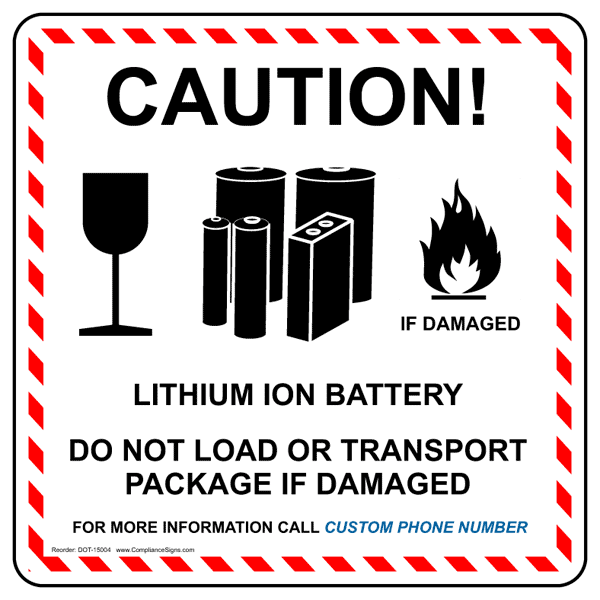
Earlier this week the US Federal Aviation Administration (FAA) issued a safety alert to US and foreign commercial passenger and cargo airlines, urging them to conduct a safety risk assessment to manage the risks associated with transporting lithium batteries as cargo.
The alert coincides with the release by the US National Transportation Safety Board which also issued two safety recommendations on Tuesday. These include recommendations to physically separate lithium batteries from other flammable hazardous materials on cargo aircraft and to establish maximum loading density requirements that restrict the quantities of lithium batteries and flammable hazardous materials.
Chris Hart, chairman of the NTSB, in a letter to the government agency that sets rules for transporting hazardous materials, said the safety recommendations were derived from the investigation of the 28 July 2011, in-flight fire and crash of Asiana Airlines Flight 991 in international waters about 80 miles west of Jeju International Airport.
Seventeen minutes after the Asiana pilots reported the fire, their B747-400F broke up over the South China Sea killing both pilots, despite desperate efforts to return for an emergency landing. The NTSB participated in the investigation, headed by the Republic of Korea’s Aviation and Railway Accident Investigation Board.
A fire on board the Asiana freighter developed on, or near, two pallets situated close together, one containing lithium-ion batteries for hybrid-electric cars and the other flammable liquids used in the production of television screens.
While the exact cause of what ignited the fire could not be determined, the NTSB is concerned that in the event of an in-flight fire in close proximity of rechargeable batteries to other flammable cargo would increase the severity of the fire and reduce the time the flight crew has to respond, Hart told the Pipeline and Hazardous Materials Safety Administration (PHMSA).
Rechargeable lithium batteries can experience ‘thermal runaway’ in which a chain effect takes place with batteries igniting those next to it in rapid succession, creating fires that can burn as hot as 660 degrees Celcius – the melting point of aluminum, which is typically used in aircraft construction.
The NTSB in its letter to the PHMSA said lithium batteries carried as cargo can be:
– A fire and explosion ignition source.
– A source of fuel to an existing fire.
– Subjected to overheating that can create an explosive condition.
As such Hart said: “The National Transportation Safety Board urges the Pipeline and Hazardous Materials Safety Administration to take action on these safety recommendations to reduce the likelihood and severity of potential cargo fires and to provide additional time for the crew to safely land a cargo aircraft in the event a fire is detected.”
The PHMSA cannot issue regulations or enforce requirements for the safe transportation of lithium cells and batteries that are more restrictive than international regulations. In 2012 following intensive lobbying by the battery and consumer electronics industry, the US Congress passed a law prohibiting the government from issuing regulations on the shipment of lithium batteries more stringent than standards issued by the International Civil Aviation Organisation (ICAO).
But Congress has given PHMSA authority to enact stricter regulations if it finds credible evidence of a deficiency in the international regulations that has substantially contributed to the start or spread of an on-board fire.
For its part, the FAA is also issuing guidance to its own inspectors to help them determine whether the airlines have adequately assessed the risk of handling and carrying lithium batteries as cargo.
Recent FAA battery fire testing has again highlighted the potential risk of a catastrophic aircraft loss due to damage resulting from a lithium battery fire or explosion. It states that current halogen-based cargo fire suppression systems cannot effectively control a lithium battery fire.
As a result of those tests, the International both ICAO and aircraft manufacturers Boeing and Airbus have advised airlines about the dangers associated with carrying lithium batteries as cargo and also have encouraged them to conduct safety risk assessments.
Hazardous materials rules currently ban passenger airlines from carrying lithium-metal batteries as cargo. In addition, a number of large commercial passenger airlines have decided voluntarily not to carry rechargeable, lithium-ion batteries. The safety risk assessment process is designed to identify and mitigate risks for the airlines that still carry lithium batteries and to help those that don’t carry them from inadvertently accepting them for transport.
The FAA’s 19 January 2016 Safety Alert For Operators (SAFO) encourages airlines that previously conducted safety assessments to reevaluate them in light of new evidence from the agency’s recent lithium battery fire tests.









